The story of a one-eyed buck is one that resonates with hunters on a deep level, as it represents both survival and resilience. In the heart of Indiana, amidst the vast woods and rolling fields, a one-eyed whitetail has become the target of an archer’s ambition. This particular buck is known for its remarkable ability to survive despite its handicap, making it an elusive and prized trophy for any hunter lucky enough to cross its path.
The Legend of the One-Eyed Buck
The one-eyed buck had a reputation long before the hunt began. Local hunters had seen him around, with his distinctive appearance—one side of his face scarred and missing an eye. His backstory remains a mystery; some believed he had fought off a predator or had narrowly survived a run-in with a vehicle. However he came to be, his survival instincts were unmatched. Despite the loss of vision in one eye, the buck had learned to adapt, relying on his remaining senses to navigate the forest and avoid danger.
What made the buck even more remarkable was its size and the quality of its antlers. Known to be an older, mature buck, the one-eyed deer had an impressive set of antlers that only added to its allure. But what set it apart was the challenge it presented to hunters—this deer wasn’t easy to track or hunt. It was a ghost in the woods, rarely seen and almost always out of range.
The Hunt for the One-Eyed Buck
For the hunter, the pursuit of the one-eyed buck became a true test of patience, strategy, and persistence. After several months of scouting and tracking, the hunter knew the area the buck frequented. Early morning and late evening were the prime times for deer movement, so the archer set up in the perfect location—an area known for good sightlines and thick cover.
Days passed without much activity, but the hunter remained patient, knowing that eventually, the elusive buck would appear. The challenge was not only in spotting the deer but in getting the shot. The one-eyed buck, despite its handicap, was extremely cautious and aware of its surroundings, often moving in and out of sight before the hunter could even raise the bow.
The Moment of Truth

On one crisp Indiana morning, the hunter sat in wait as the sun began to rise. Then, a flicker of movement caught the archer’s eye—the one-eyed buck had emerged from the thick brush, moving cautiously through the forest. The buck’s distinctive antlers caught the light as it stepped into range, but it was facing away. The hunter knew the shot needed to be perfect.
With a steady hand, the archer drew the bow and took the shot. The arrow flew true, hitting its mark. The one-eyed buck was down, and the hunt was over. The moment was bittersweet—a trophy harvested, but a unique creature with a story that would live on.
Legacy of the One-Eyed Buck
The one-eyed buck became a symbol of survival, strength, and the unpredictable nature of the wild. For the hunter, it was a victory earned through hard work and determination. It was more than just a hunt—it was the fulfillment of a challenge and a testament to the resilience of nature.




